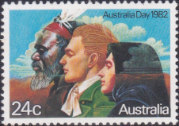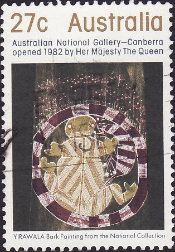History
Timeline results for
Found 1175 results for your search. Showing page 20 of 59.
1980
-
Jim Hagan is the first Australian Aboriginal person to address the United Nations in Geneva taking Indigenous matters to the international stage when the Fraser government fails to stop mining on sacred sites on Noonkanbah Station, about 300 kms west of Broome in northwest Western Australia.
-
Ernie Bridge (Australian Labor Party) becomes the first Aboriginal member of the Parliament of Western Australian when he wins the seat of Kimberley. He later becomes the first Aboriginal person to hold a ministerial office.
1981
-
Pitjantjatjara people of South Australia are granted land under the Pitjantjatjara Land Rights Act (SA). A large area of the state is returned to the Anangu Pitjantjatjara. Anangu Pitjantjatjara, a corporate body, is established to administer some 100,000 square kms of land for the Anangu people.
-
Secretariat of the National Aboriginal and Islander Child Care established (SNAICC). SNAICC represents the interests on a national level of Australia’s 100 or so Indigenous community-controlled children’s services.
-
Michael Anderson, the only surviving founder of the Aboriginal Tent Embassy, becomes the first Aboriginal Australian to address the United Nations.
-
The Australian government takes issue with using the word 'treaty' in the context of Aboriginal sovereignty in a letter by the Minister for Aboriginal Affairs, Peter Baume: "Although the word 'Treaty' is occasionally used in the domestic context... [it] is ordinarily used to refer to a kind of international agreement. In that sense it is clearly inapplicable to any form of agreement between the Commonwealth and Aborigines since the latter are not a 'nation'." [1]
The Senate resolved on 24 September 1981 that the Senate Standing Committee on Constitutional and Legal Affairs should examine the feasibility... of servicing a compact or Makarrata between the Commonwealth Government and Aboriginal Australians.
— Peter Baume, Minister for Aboriginal Affairs [1] -
The Minister for Aboriginal Affairs, Mr. Peter Baume, writes to the then Chairperson of the National Aboriginal Conference, Mr. Bill Bird, in response to a letter advising him of the 27 items that had emerged as a preliminary list of matters that were being considered for inclusion in the Makarrata/treaty.
1982
-
The Northern Land Council sign an agreement with Pancontinental Mining Limited allowing the company to mine uranium at Jabiluka, 230 km east of Darwin in the NT. The mine site is surrounded by, but not part of Kakadu National Park. World Heritage listed for both its environmental and cultural importance, Kakadu is Australia’s largest national park. In 1998 thousands came from around Australia and across the world to support the Mirarr people and blockade the proposed Jabiluka mine.
-
Death of Joe Pat in Roebourne gaol (WA). The first death in custody to be widely protested ultimately leads to the setting up of the Muirhead enquiry.
-
Mark (Gordon) Ella, an Aboriginal rugby union player, often considered as one of Australia’s all-time greats in that sport, is named Australian of the Year.
-
The National Aboriginal Conference developed its own proposal which created a way for every Aboriginal nation to negotiate its own treaty, compact or agreement and it avoided nations being forced into a single national proposal.
-
Eddie Mabo commences land rights proceedings in the High Court of Australia.
-
Ken Colbung, a Nyoongar Aboriginal activist from Western Australia, receives the Order of Australia Medal for his services to the Aboriginal community. Ken was heavily involved in Aboriginal politics and the main architect of the Aboriginal Heritage Protection Act which came into force in 1972. [2]
-
Victorian Premier John Cain announces legislation is to be passed recognising the Aboriginal ownership of the Framlingham Forest near Warrnambool.
-
Aboriginal people at the Hermannsburg mission (131 km southwest of Alice Springs) are granted freehold title.
-

The Australia Day 1982 stamp tried to convey a sense of unity of diverse Australians. A stamp for Australia Day shows the head of an Aboriginal man, along with that of a European colonist and an immigrant. The stamp's design symbolises the three waves of migration to Australia: Aboriginal people from south-east Asia, the British and European post-war immigrants.
-
The Senate Standing Committee on Constitutional and Legal Affairs is presented with a recommendation that an amendment to the Constitution for the Treaty-making process should be the same form as Section 105A of the Australian Constitution, which would then enshrine Aboriginal inherent sovereign rights. The Fraser government gives in-principle support to this proposal.
-
Queensland Aboriginal people protest at the Commonwealth Games.
-

The stamp shows Gurgurr the Moon man, and his dog Mulutji. Australia Post issues a stamp commemorating the opening of the National Gallery, Canberra. The design shows an Aboriginal bark painting of Gurgurr the Moon man, and his dog Mulutji as they appear on the moon. The artist is not mentioned.
-
Australia Post issues a set of four stamps themed Aboriginal Culture in Music and Dance. It is the first time actual Aboriginal work appears on Australian stamps. All designs show bark paintings of Mimi spirits dancing. The artists are David Milaybuma (27c), Lofty Nabardayal (40c), Jimmy Galareya (65c) and Dick Nguleingulei-Murrumurru (75c).

Mimis are fairy-like beings of Arnhem Land (NT) and have extremely thin and elongated bodies. They live in rock crevices and sometimes taunt people.


